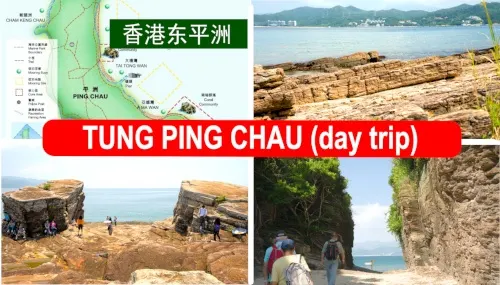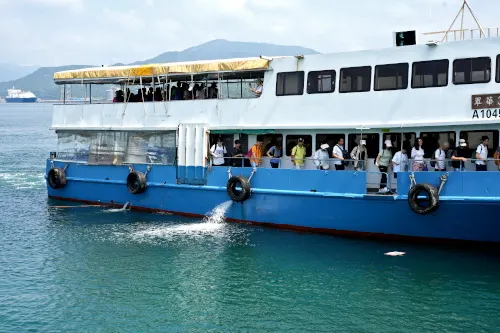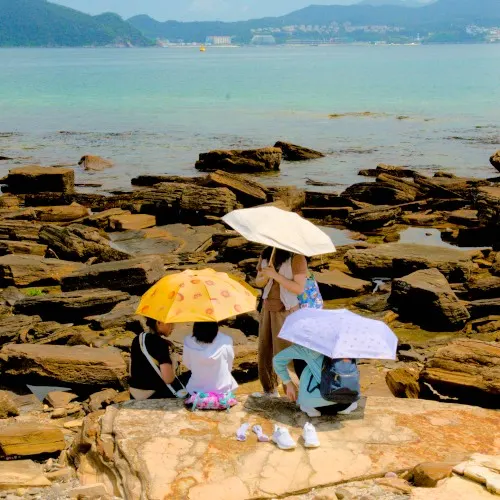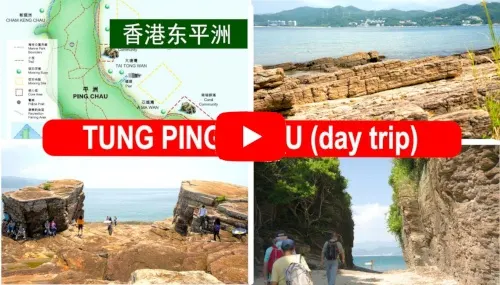
Today, I will visit a place of interest in Hong Kong that my brother has been talking about- Tung Ping Chau. Based on my brother's description, I want to see if the real place looks like what I have pictured.
Tung Peng Chau is a small island offshore of Hong Kong's main island worth visiting. It is also known as Ping Chau, an island in Mirs Bay, Hong Kong, close to the border with Guangdong Province in mainland China. It is the most easterly point of the Hong Kong territory and is part of the Hong Kong UNESCO Global Geopark.
How to go to Tung Ping Chau from Hong Kong island
We woke early to catch the first ferry, as the pier was far from our house. We took the No. 70 bus from Aberdeen station to the MTR Hong Kong station. Once there, we boarded the MTR and headed towards University Station. After that, we walked to the Ma Liu Shui Public Pier for about ten minutes.

By the time we arrived, there were already over 100 people queued up in front of us. We had to wait until 10:00 a.m. to board the ferry to Tung Peng Chau. The cost of the return ticket was 90 Hong Kong dollars. Although it was possible to purchase the ticket online, my brother, who qualified for the senior discount and only had to pay 2 Hong Kong dollars for a single trip, decided to buy the ticket on the spot. This was because the senior discount was not available online.

The ferry we boarded was quite large and could accommodate a few hundred people. Although there were sufficient seats for everyone, the facilities were quite basic. However, there are toilets available on the ferry.
The ferry slowly sailed away from the main Hong Kong Island, taking about one and a half hours to reach Tung Peng Chau. As we approached, we saw the whole island, which was quite flat. This is why it's called Tung Peng Chau, meaning 'flat island of the east.'

Watch the video we shot at Tung Ping Chau (at the end of this article) 👇👇.
The main attractions at Tung Ping Chau
After getting off the ferry, we stopped by the signboard near the pier to take some photos.


It is necessary to use the public restroom nearby before embarking on the trail since it will take a few hours before we return.

We plan to visit all the significant viewpoints on the island, which include the following. However, it depends on our speed and timing as we must return to the pier before the last ferry departs for Hong Kong Main Island.
- Old villages (housed built with siltstone)
- A Ma Wan (阿妈湾/cobble beach with coral fragment)
- Tin Hau Temple (天后宫)
- Kang Lau Shek (更楼石/sea stack)
- Lung Lok Shui (龙落水/Cherty layer)
- Cham Keng Chau (斩颈洲)
Here is the map of Tung Ping Chau from the Agriculture, Fisheries, and Conservation Department of Hong Kong.

Brief information about the rock formation

- Based on the information on the signboard, Tung Ping Chau is believed to have the youngest rocks in Hong Kong. The rocks are around 55 million years old and were formed when sediments were eroded and consolidated, resulting in sedimentary rocks, mainly fine-grained siltstone.
- Some geologists hypothesize that over 50 million years ago, the surrounding mountains were subjected to abundant sunlight and rainfall, causing plant debris, sand, and mud to be carried away and deposited in the lagoon. The sediments were then layered and compacted, eventually turning into rocks. Over the next tens of millions of years, the rock formation was subjected to numerous fluctuations in sea level and long-term weathering, eventually becoming the island we see today.
- The coastal rocks display an irregular structure with cracks resembling bean curd pieces or fish scales. These rocks were initially joined together but were fractured due to strong compression. Over time, the cracks widened due to wave erosion and weathering, resulting in today's unique and distinctive landscape.
Various viewpoints we visited
The weather was getting hot while walking along the Ping Chau Country trail. Although trees shaded some areas along the trail, it was scorching hot once we reached the rocky and seaside areas.

a. Old villages

Tung Ping Chau Island has over 350 abandoned buildings, and some remaining structures are overgrown by banyan trees and vines. However, there are still some old houses and villages that are inhabited. Some old houses on the island have been converted into restaurants. These restaurants offer a unique dining experience in a rustic setting, and they serve some of the most delicious seafood dishes in the area.
b. Tin Hau Temple (天后宫) / A Ma Wan (阿妈湾)
We didn't hike for long before arriving at the Tin Hau Temple, a historic temple dedicated to the goddess of the sea. The temple was built in 1765, is located in the village of Sha Tau, and can be easily accessed just off the beach at A Ma Wan.

Like many other fishermen residing in China's coastal regions, most of Tung Ping Chau's inhabitants, who hailed mainly from Guangdong province, followed the custom of worshipping Ting Hao, the sea goddess. The locals believed she could bless and safeguard them while they were at sea.
This temple exemplifies a typical Qing vernacular Chinese temple structure, featuring a layout of two halls and one courtyard. The temple has been preserved well and still bears much of its original appearance.

Tung Ping Chau is a good place for snorkeling and diving. The crystal-clear waters around the island are home to various marine life, including vibrant coral reefs. In addition, Tung Ping Chau is a popular destination for scuba diving, with several dive sites around the island. The unique geological formations around the island also make it an interesting place to explore underwater.

c. Kang Lau Shek (更楼石)

Next, we arrive at Kang Lau Shek. It boasts a breathtaking wave-cut platform replete with rock pools and algae. This platform is the largest and most renowned in Hong Kong, stretching 33 meters from the sea.
At its center are two towering rocks, known as sea stacks, which lend the attraction its name.

After Kang Lau Shek, we found a shaded area to have lunch and rest before continuing to Lung Lok Shui.

d. Lung Lok Shui (龙落水)

Lung Lok Shui is a rare cherty layer located in Tung Ping Chau. It is said to bear a striking resemblance to the spine of a dragon entering the sea. The triangular ridge-like margin of the rock formation enhances its dragon-like appearance.
e. Cham Keng Chau (斩颈洲)

The final stop before returning to the pier was Cham Keng Chau, also known as "beheading island" or "decapitation island" in English. It is named after its unique appearance, resembling a headless body or a head severed from the mainland.

We enjoyed taking our time to appreciate the rocks, nature, and scenery but soon realized it was time to return to the pier. Due to the ongoing public holidays, the public ferry was full, and many tourists were present. We were quite tired, not from the walking distance, but rather because of the scorching hot weather. Further, there were few places with shade on the island.

What to bring when visiting Tung Ping Chau?
Here is a list of items to bring for a comfortable and enjoyable visit:
- Water and Food: The island has limited dining options, so bringing enough water and food for your visit is advisable. Consider packing simple food like sandwiches or energy bars to keep you fueled while exploring the island.
- Sun Protection: Bring sunglasses, a sun hat, and sunscreen to protect yourself from the sun.
- Comfortable Shoes: The island's terrain can be uneven and rocky in some areas, so wearing comfortable, sturdy shoes for hiking is recommended.
- Swimwear and Towel: If you plan to dip in the island's clear waters or relax on the beach, pack your swimwear and a towel.
- Insect Repellent: To ward off pesky insects, bring insect repellent to ensure a more comfortable experience.
- Cash: While some stores may not accept electronic payment methods, having cash is good.
- Camera or binoculars: Tung Ping Chau offers stunning natural landscapes and wildlife, so please bring a camera or binoculars to capture these moments.
- Ferry Schedule: Before your visit, check the ferry schedule to ensure you have the most up-to-date information on departure and return times.

If you enjoy Tung Ping Chau, you might also be interested in visiting Cape D'Aguilar, another natural attraction in Hong Kong. Check out our article about our trip to Cape D'Aguilar.
If you ever visit Hong Kong, Tung Ping Chau is a must-visit destination, offering a glimpse of nature and a change of pace from the city's bustling atmosphere, traditional culture, and delicious food. During our visit, we also captured a video you can watch on YouTube by following the link below.
Watch the video we shot at Tung Ping Chau 👇👇.

